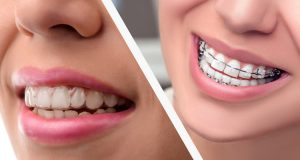The two most popular orthodontic treatments today are braces and Invisalign. It's a heated debate as to which is better, but the answer largely depends on the person and their personal experience.
 Invisalign is an orthodontic treatment that uses a series of custom-made, clear aligners to gradually align your teeth without the use of metal brackets or wires. The aligners are designed to be comfortable and are virtually invisible when worn. Invisalign aligners can be removed at night or during meals but should still be worn for the recommended time of 22 hours a day for the fastest treatment time. Braces require more intervention, as they have to be adjusted by the orthodontist at least once a month. Invisalign have been shown to be faster, as they require less visits for adjustments, and can take up to one year to complete.
Invisalign is an orthodontic treatment that uses a series of custom-made, clear aligners to gradually align your teeth without the use of metal brackets or wires. The aligners are designed to be comfortable and are virtually invisible when worn. Invisalign aligners can be removed at night or during meals but should still be worn for the recommended time of 22 hours a day for the fastest treatment time. Braces require more intervention, as they have to be adjusted by the orthodontist at least once a month. Invisalign have been shown to be faster, as they require less visits for adjustments, and can take up to one year to complete.
Invisalign uses 3D imaging and computer graphics technology that isn't bulky like braces. Both work fast to straighten teeth; however, there is no clear winner between braces and Invisalign because each treatment has its own pros and cons.
Pros and Cons of Invisalign
Invisalign is a popular invisible orthodontic treatment that helps people straighten their teeth. It is better than braces as it can be removed or taken out for some activities.
Invisalign offers a solution to the two most common issues with traditional braces: discomfort and visibility. Invisalign aligners are clear, virtually invisible and comfortable to wear. This means that you can have the smile of your dreams without anyone being able to tell that your teeth have been straightened!
Pros:
- No metal brackets or wires that can be seen
- Less expensive than traditional braces
- Treatment time is quicker than traditional braces
- Improves self-confidence by making your teeth straight
- Trays are removable and can be taken out at any time
- No food limitations
Cons:
- They must be cleaned daily
- Some people find the aligners difficult to wear, which can lead to compliance issues
What are the Pros and Cons of Braces?
Braces are used to straighten teeth and make them look nice. Braces work by using bands which are fastened onto the front of your teeth, along your gum line where your teeth will eventually meet when they are straightened out. The bands pull the edges of each tooth into place until they all line up properly.
Pros:
- Braces can straighten your teeth and give you a better smile.
- Braces can lower your risk for tooth decay and gum disease.
- Children with braces might find it easier to learn how to brush their teeth and take care of them.
- Braces might help improve speech patterns or fix speech impediments.
- Braces may improve your bite problem by moving teeth into the correct place.
Cons:
- Your mouth may become tender as the braces apply pressure on the gums or tongue
- Cost of treatment can be high depending on situation and what needs to be done - Some orthodontists diagnose tooth decay or gum disease before prescribing treatments
- Some people don't like the way their teeth look while they have braces on as they can be aesthetically unpleasing (either because their teeth are pushed together or they get meals stuck in their mouth).
- Some people become sensitive to hot or cold foods while wearing braces because they feel everything more intensely than usual.
